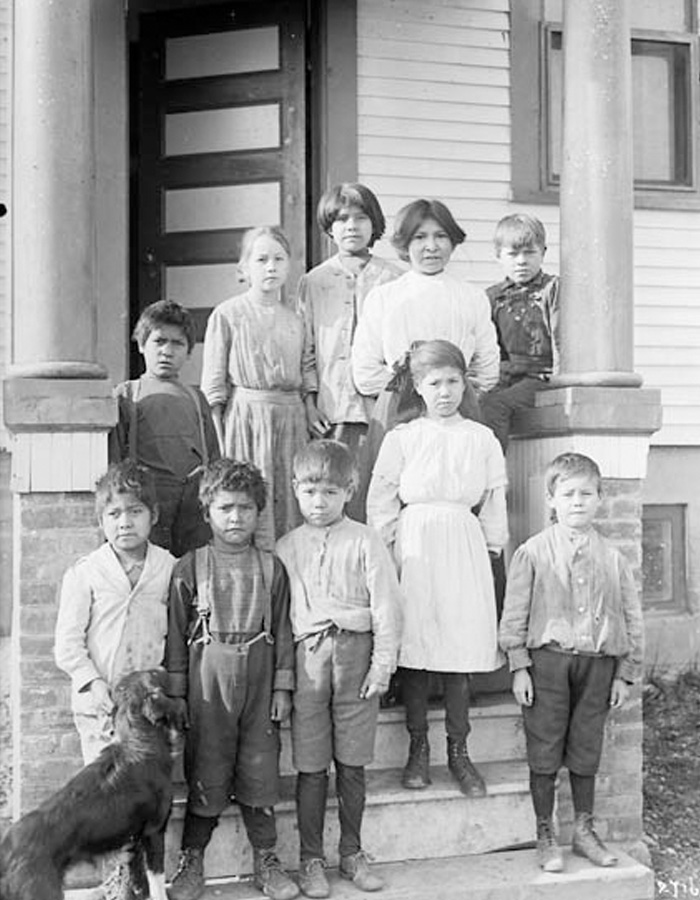This play, written by Elder Imelda Perley, was performed by Grade 6 students for the Wolastoqey Chiefs on Treaty Day 2021. The play honours the treaty-making of the 1725 Mascarene Treaty, described in the Covenant Chain of Treaties section of this lesson, and how treaties are related to keeping memories alive of those who went before us and to those who are not yet born.
If possible, try performing this play with puppets in both languages. Using puppets will help young people to perform it with more confidence. You can use the Wolastoqey Latuwewakon app at the beginning of this resource for pronunciation.
Amsqahs Kishomawotimok
Elikotok 1725
Neket Pihce, Pihce pihce, pihce, pihce eci wolawsultihtponik psiw skicinuwok.
A long time ago, a long, long, long, long time ago, Wolastoqewiyik lived a good life.
Mihqitahatomuniya eli ’cuwi ’sosseyuwahtit psiw ’tolnapem.
They remembered to treat everyone with respect.
Psiw elakumahtit, wisawyicik, mokoseweyicik naka wapeyicik, newiqatihtit, alituwiyahtit, samaqanuwicik kapiw ote cucuhcok.
All their relatives, the yellow families, the black families and the white families, the four-leggeds, the ones who fly, the water people, even the ones who crawl upon Mother Earth.
Wapeyihtit petapasihtit, wonitahasiniya elkimutopon, psiw ote keq ’koti nihkanahtpatomuniya naka psiw ote keq ’koti tpeltomuniya.
When the White families came, they forgot the teachings of harmony, they wanted to control everything and to own everything.
Nit weci matonakhotimok, kehsi matonakhotimok.
That is when the fighting for land and rights began, there was lots of fighting.
Kehsi matonakhotimok neket, tokiw kishamawotihtit wapeyicik naka skicinuwok weci ehqi kotuwihponotihtit.
There was so much fighting back then, until both the white families and the Wabanaki people decided to stop their fighting.
Wapeyit Kincemoss Cahci ’tolkotomon weci Pilasq wikhasik: ’kisuwikhomuniya pilasq kenoq ikolismanuwikhasu
King George of England ordered his subjects to negotiate Treaties with the Red Families (People of the Dawn, Wolastoqewiyik, Penobscots, Mi’kmaq, Passamaqoddies): The Treaty was written in their language, English.
Enter Cihqonaqc naka Qapit
Qapit: Cihqonaqc keq nit “Treaty”?
Beaver: Turtle, what is a “Treaty”?
Cihqonaqc: Nqoss, ya nit neket pihce, pihce, pihce pihce kishamawotihtit Wapeyihtit naka Skicinuwok weci ehqi matonotultihtit naka mawawsultiniya.
Turtle: Son, a long, long, long, long time ago, an agreement between nations was signed by the white family and Wolastoqewiyik to stop fighting and to live in harmony with each other forever.
Tuhkis: Qinote? Tayuwek Nit?
Mouse: Really? When?
Cihqonaqc: Tuciw elikotok 1725.
Turtle: Since the year 1725.
Tuhkis: Kitiyena! Keq Ewikhasik?
Mouse: Wow! What is Written?
Mus: Askomiw tehc skicinuwok kisi Kotunkahtuwok tan tehpu tama.
Moose: Hunting Rights are preserved forever.
Tuhkis: Qinote? Keq Apc?
Mouse: Really? What Else?
Muwin: Askomiw tehc Skicinuwok kisi Natanhotuwok tan tehpu tama.
Bear: Fishing Rights are preserved forever.
Mahtoqehs: Qinote? Keq Apc?
Rabbit: Really? What Else?
Cihpolakon: Askomiw tehc Skicinuwok kisuwehkawa sipsis ’ciw skicinuwimiyahtihtit Naka Wetawsultihtit.
Eagle: The Right to Ceremonies and fowling will be preserved forever.
Tihtokol: Qinote? Keq Apc?
Owl: Really? What Else?
Malsom: Askomiw the Skicinuwok ’Pomihptuniya Skicinuwipomawsuwakon.
Wolf: Our Aboriginal rights are preserved forever, our language, our way of life.
Matuwehs: Qinote? Keq Apc?
Porcupine: Really? What Else?
Qaqsoss: Askomiw tehc Skicinuwok naka Wapeyihtit Sankimawawsultuwok.
Fox: Peace and Friendship with our White Brothers and Sisters will be preserved forever.
Espons: Qinote? Keq Apc?
Raccoon: Really? What Else?
Apikcilu: Wolasuweltomuhtine!
Skunk: Let us Give Praise and Thanks to our Ancestors for Protecting our Rights!
Wolasuweltomuwakon
Nuhkomossok naka Nmuhsumsok
Grandmothers and Grandfathers
Woliwon kisi Wolankeytomeq
Thank you for preserving
Skicinuwawsuwakon
Our Aboriginal Rights
Nilun oc Tokec
It is now our turn
Wolankeyutomonen
To preserve them
’Ciw Weckuwapasihtit
For the Ones Who are Not yet Born.
Nit Leyic!
May that be the Truth!

This animation describes how indigenous people viewed treaty-making. It can follow the covenant chain of treaties section that is in the background notes for the teacher. Emphasis can be placed on three things: 1) interconnectedness of the treaties 2) intergenerational understanding of those who signed the treaties over a fifty-five year span and 3) interdependency between First Nations and the British (and now the Federal Government). For Indigenous people, treaty-making operated on the principle of extended family. Therefore, a treaty is considered a sacred vow or Covenant. Treaty-making is part of a sacred order and every time a treaty is made it is adding to the order. Through a series of questions, dates and main components of each treaty, the animation will build on those three understandings.
To reinforce the chain of treaties timeline, have the students complete the following animation.
Important note: Do not hesitate to click on “Pause” in the progress bar while looking at the animation, so you can observe more details in the pictures or the illustrations.




